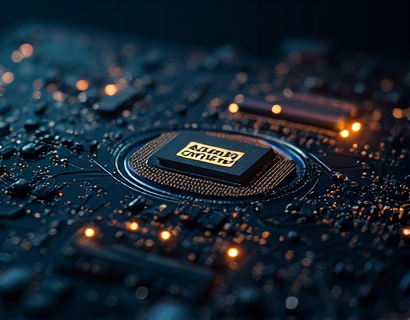Smart Contract Solutions for Pegged Token Creation and Seamless DeFi Exchange
In the rapidly evolving landscape of decentralized finance, the creation of stable digital currencies pegged to established assets like UCASH represents a significant advancement. This article delves into the innovative use of smart contracts to facilitate the creation of these pegged tokens and enable seamless bidirectional trading on decentralized exchanges. By leveraging the power of blockchain technology, this approach not only enhances the stability and flexibility of digital assets but also sets a new standard in the crypto space.
The concept of pegged tokens involves creating digital currencies that maintain a fixed value relative to a stable asset, such as UCASH. This stability is crucial for facilitating trust and adoption in the decentralized finance (DeFi) ecosystem, where volatility has historically been a significant barrier. Smart contracts play a pivotal role in this process by automating the mechanisms required to maintain the peg, ensuring that the value of the token remains consistent with the underlying asset.
Understanding Pegged Tokens
Pegged tokens are a type of stablecoin designed to maintain a stable value by being pegged to another asset, commodity, or currency. In the context of UCASH, these tokens would be pegged to the UCASH price, providing users with a reliable store of value and a medium of exchange. The use of smart contracts to create and manage these tokens offers several advantages, including transparency, security, and automation.
A smart contract is a self-executing contract with the terms of the agreement directly written into code. These contracts run on a blockchain, ensuring that all transactions are transparent, immutable, and verifiable. For pegged token creation, smart contracts are programmed to automatically adjust the supply of tokens in response to market conditions, thereby maintaining the peg.
Smart Contract Mechanisms for Pegged Token Creation
The process of creating pegged tokens using smart contracts involves several key steps. First, a smart contract is deployed on a blockchain network, such as Ethereum, which contains the rules and logic for maintaining the peg. This contract is programmed to monitor the price of UCASH and adjust the supply of the pegged token accordingly.
One common mechanism used in these smart contracts is the Overcollateralized Collateralized Debt Position (OCDPD). In this setup, users deposit UCASH as collateral to mint pegged tokens. The smart contract calculates the required collateral ratio, typically set above 100%, to ensure that the value of the deposited UCASH exceeds the value of the minted tokens. This overcollateralization provides a buffer against price fluctuations.
When the price of UCASH increases, the smart contract automatically burns a portion of the pegged tokens to maintain the peg. Conversely, if the price of UCASH decreases, the contract can mint additional tokens to keep the supply in line with the peg. This dynamic adjustment ensures that the token remains stable and trustworthy.
Benefits of Smart Contract Pegged Tokens
The use of smart contracts for pegged token creation offers numerous benefits that enhance the overall DeFi experience. One of the primary advantages is the increased stability of digital assets. By maintaining a fixed value relative to UCASH, these tokens reduce the risk associated with price volatility, making them more attractive to investors and users who seek a stable store of value.
Another significant benefit is the enhanced flexibility provided by smart contracts. These contracts can be programmed to include various features, such as automatic rebalancing, liquidity provision, and governance mechanisms. This flexibility allows developers to create more sophisticated and user-friendly financial products, catering to a wide range of needs within the DeFi ecosystem.
Moreover, the transparency and security offered by blockchain technology ensure that all transactions and contract executions are visible and tamper-proof. This level of transparency builds trust among users and reduces the risk of fraud or manipulation, which has been a concern in traditional financial systems.
Seamless Bidirectional Trading on DeFi Exchanges
One of the most exciting applications of smart contract pegged tokens is their integration into decentralized exchanges (DEXs). These exchanges enable users to trade pegged tokens for UCASH and vice versa in a seamless and bidirectional manner. The smart contracts underlying these DEXs ensure that trades are executed automatically and fairly, without the need for intermediaries.
The process of trading pegged tokens on a DEX involves simple steps. A user locks in UCASH to mint pegged tokens, which are then stored in their wallet. To convert the tokens back to UCASH, the user can simply initiate a trade on the DEX, where the smart contract automatically burns the tokens and releases the corresponding amount of UCASH. This bidirectional functionality enhances liquidity and provides users with greater control over their assets.
DEXs that support smart contract pegged tokens also benefit from reduced counterparty risk, as there is no central entity involved in the trading process. This decentralized approach aligns with the core principles of DeFi, promoting a more open and accessible financial system.
Enhancing the DeFi Ecosystem
The introduction of smart contract pegged tokens and seamless DeFi exchanges represents a significant step forward in the DeFi ecosystem. By providing stable and flexible digital assets, these innovations address some of the key challenges faced by the industry, such as volatility and trust issues.
Furthermore, the use of smart contracts in pegged token creation and DeFi exchanges fosters innovation and competition among developers. This competition drives the development of new features and improvements, leading to a more robust and user-friendly DeFi landscape. As more projects adopt these technologies, the overall ecosystem becomes more resilient and attractive to a broader audience.
Challenges and Considerations
While the potential of smart contract pegged tokens and DeFi exchanges is immense, there are several challenges and considerations that need to be addressed. One of the primary concerns is the complexity of smart contracts, which can lead to bugs or vulnerabilities if not properly audited and tested. Ensuring the security and reliability of these contracts is crucial to maintaining user trust and preventing potential losses.
Another consideration is the regulatory environment surrounding DeFi and stablecoins. As governments and regulatory bodies begin to take notice of these technologies, compliance and legal frameworks will become increasingly important. Developers and projects must stay informed about regulatory changes and ensure that their solutions comply with relevant laws and regulations.
Additionally, the scalability of blockchain networks remains a challenge for widespread adoption. While platforms like Ethereum are making strides with upgrades like Ethereum 2.0, there is still a need for more efficient and cost-effective solutions to handle high volumes of transactions.
Future Prospects
Looking ahead, the integration of smart contract pegged tokens and DeFi exchanges is poised to revolutionize the financial landscape. As technology continues to advance, we can expect to see more sophisticated and user-friendly financial products emerge. The combination of stable digital assets and decentralized trading platforms will likely become a standard feature in the DeFi ecosystem.
Moreover, the cross-chain interoperability of these tokens could open up new possibilities for global financial inclusion and access. By leveraging the strengths of different blockchain networks, users can benefit from a more interconnected and efficient DeFi environment.
In conclusion, smart contract solutions for pegged token creation and seamless DeFi exchanges represent a transformative approach to decentralized finance. By enhancing the stability and flexibility of digital assets and enabling bidirectional trading, these innovations set a new standard in the crypto space. As the technology matures and adoption grows, the potential for a more stable, secure, and accessible financial system becomes increasingly tangible.










































